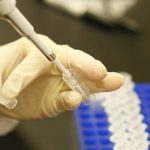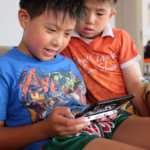New experiments with stem cells suggest we may one day be able to replace damaged neurons in the ear, potentially helping some of the 275 million people worldwide who suffer from hearing loss.
Hearing loss can be triggered by factors such as heredity, infection, physical trauma, aging, or, most commonly, exposure to excessive noise. Regardless of what triggers deafness, all forms of irreversible hearing loss involve damage to two main cell types within the ear: the hair cells that amplify incoming sounds and convert them to electrical stimuli, and the neurons that carry those electrical stimuli to the brain. For people whose hearing loss is caused by damage to the hair cells, treatments like hearing aids and cochlear implants can lead to substantial improvements in hearing and quality of life.(a) However, for people whose deafness is caused by loss or damage to the auditory nerves, hearing aids and cochlear implants offer no help because the sound signals that are produced cannot be translated to the brain.
For people with neuropathic (i.e. neuron-related) deafness, there are currently no effective therapies and hearing loss is irreversible. Scientists and clinicians have hoped that replacing the damaged cells may lead to improvements in hearing. The problem is that the lost cells are neurons, and neurons are notoriously hard to grow and maintain. The authors of a recent paper in Nature had previously isolated and described fetal stem cells that were able to generate the key neurons involved in hearing.(b) However, as is often the case with non-embryonic stem cells, these cells had limited ability to reproduce themselves and were deemed unsuitable for therapy. The scientists are now working with human embryonic stem cells and, in their most recent paper, they describe a method for converting the stem cells into the neural progenitor cells (i.e. cells that will grow into neurons) of the ear.1
 After creating and characterizing these cells, they transplanted them into gerbils that had been given nerve deafness by a chemical treatment. The cells survived transplantation and went on to give rise to new neurons to replace the ones that had been chemically destroyed. When the researchers tested the gerbils that had received the neural progenitor cells, they found, on average, a fifty percent improvement in hearing compared to the gerbils that did not receive the treatment. The authors also state that the fifty percent improvement represents a wide-range of responses and that, in some cases, the hearing recovery was nearly complete. If this therapy can be translated from gerbils to humans, it could mean a drastic improvement in quality of life for people suffering from a currently untreatable form of deafness.
After creating and characterizing these cells, they transplanted them into gerbils that had been given nerve deafness by a chemical treatment. The cells survived transplantation and went on to give rise to new neurons to replace the ones that had been chemically destroyed. When the researchers tested the gerbils that had received the neural progenitor cells, they found, on average, a fifty percent improvement in hearing compared to the gerbils that did not receive the treatment. The authors also state that the fifty percent improvement represents a wide-range of responses and that, in some cases, the hearing recovery was nearly complete. If this therapy can be translated from gerbils to humans, it could mean a drastic improvement in quality of life for people suffering from a currently untreatable form of deafness.
Endnotes
- W. Chen, N. Jongkamonwiwat, L. Abbas, S.J. Eshtan, S.L. Johnson, S. Kuhn, M. Milo, J.K. Thurlow, P.W. Andrews, W. Marcotti, H.D. Moore, M.N. Rivolta (2012) “Restoration of auditory evoked responses by human ES-cell-derived otic progenitors,” Nature, 490(7419): 278 – 282.
Sidenotes
- (a) Cochlear implants are the closest thing to a “miracle cure” for some deaf people, as can be seen in a number of online videos showing the moment an implant is activated for the first time. The implants basically act as artificial hair cells, converting sound, and particularly speech, into electrical impulses that are fed directly into the auditory nerves.
- (b) Stem cells are the much touted and sometimes controversial cells that possess a characteristic known as pluripotency: the ability to generate any cell type in the body. While stem cells can be found in adult humans, the most effective are often those sourced from embryos or fetuses, the harvesting of which is the subject of considerable bioethical debate.





